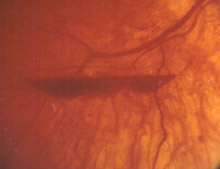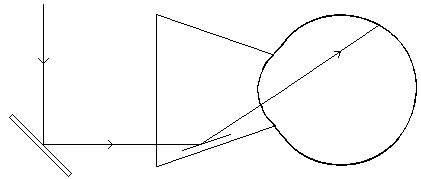DIABETES
Diabetes can cause changes in the eyes. Therefore the eyes of an diabetic person are examined regularly. The smallest vessels of the retina, the capillaries, may become closed or their diameter may become wider than normal. This causes oedema, swelling of the retina and small haemorrhages. This is called diabetic retinopathy. If the control of diabetes is good, changes in the retina develop very slowly.
A.  |
B.  |
Fig.18a. Fluorescein angiograms of retinal vessels in patients with diabetic retinopathy. In diabetic retinopathy the wall of capillaries may be damaged so that fluid diffuses into the retinal tissue more than normally causing oedema. Small distentions of the wall, microaneuryms, are seen in fluoresein angiograms as bright dots. This angiogram was taken in 1974 when photocoagulation was used instead of laser treatment. The round black areas are scars of the photocoagulation burns. Changes of the vessel wall become less and less after the treatment and during good basic care of diabetes. Central vision of this person is good 25 years after a period of rapidly increasing vascular changes, which demonstrates the great value of both photocoagulation treatment and good basic care.
 |
Fig.18b.Collection of blood between the retinal surface and vitreous after bleeding from new formed vessels, meovascularisation. There is a risk of a bleeding like this bursting into vitreous. |
In some diabetic patients, new formed vessels start to grow on the retina. These vessels have very thin walls and bleed easily. The blood may collect in front of the retina or burst into the vitreous making the image blurred. Diabetic changes in the retinal vessels are destroyed with laser burns.

Fig.18c. Examination using 3-mirror contact lens on the cornea. The contact lens contains mirrors that reflect the light into different parts of the retina. A lens like this is used also during the laser treatment.
Laser treatment means that small laser burns are used to reduce retinal oedema and to destroy vessels that might cause bleeding. In most cases the diabetic changes can be brought under control, the vision of the patient remains good. Sometimes so much of the retina must be destroyed that night vision is decreased. It is, however, a reasonable price if the other functions of the retina remain good or fairly good.